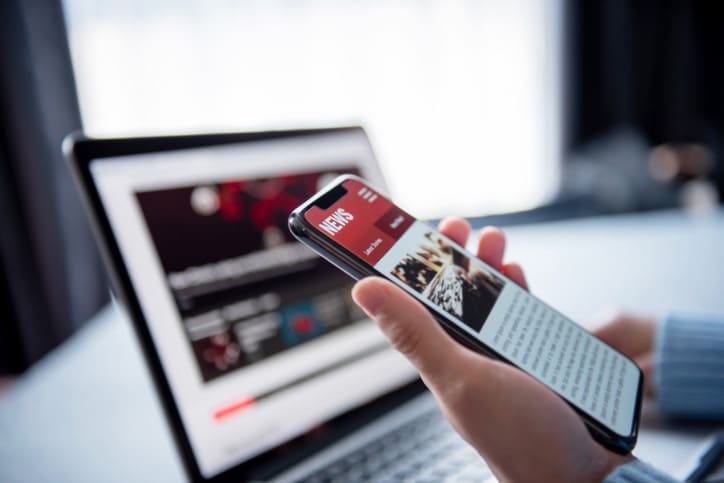Misinformation is rampant in the world today. One study found that nearly 80% of United States consumers reported seeing misinformation regarding the COVID-19 pandemic, and 70% of Europeans report regularly seeing fake news. Outside of isolated cases, virtually every human being has likely consumed misinformation at some point. But what does misinformation mean and how does it differ from disinformation?
Misinformation describes the general spread of false information, whether or not the person knew the information was false. Meanwhile, disinformation is false or inaccurate information that is deliberately framed to be deceptive to those who consume it. Businesses and individuals have been hyper-aware of misinformation since the 2010s when the term “fake news” seemed to be plastered on virtually every story on a news feed.
But misinformation is not new—organizations have pedaled misinformation for centuries. In the early 1900s, flagrantly false advertisements could be seen as an early form of misinformation before the Federal Trade Commission Act was established by the U.S. Political propaganda is another age-old tool used to sway public opinion with murky facts.
Today, misinformation occurs more commonly in the form of fake websites, news stories, and manipulated content. Misinformation can incite rage, contribute to growing social divides, and lead people to take action based on false pretenses. As the fight against misinformation and disinformation campaigns continues, companies must consider the political, economic, and regulatory elements at play—despite the intense focus on technical-first approaches.
What can your business do to ensure neither it nor your employees fall victim to misinformation? We’ll discuss that and more in this article.
Team Constella
VP of Threat Research
The Rise of Misinformation & Disinformation
As we said before, misinformation has been around for quite some time. It’s even hard to determine whether or not misinformation has increased in recent years. So why is it such a major issue today?
Research from the German Marshall Fund Digital found that Facebook engagement on articles from news outlets that frequently share misinformation nearly tripled from 2016 to 2020.
While mis/disinformation is just as common as ever, a single piece of news—whether intentionally incorrect or not—can spread much more quickly than ever. Why? Mainly because of the internet and social media platforms and the simplicity of sharing information today.
A study by Tom Buchanan, professor of Psychology at the University of Westminster, analyzed why misinformation is so well-traveled on social media platforms. The largest contributing factors were simply that:
- The user believed the information to be true.
- The user had beliefs consistent with the views shared in the information.
The latter factor describes confirmation bias, which is the propensity to look for information consistent with one’s beliefs. In summary, people tend to believe what they want to be true, not what is really true.
The 5 Dangers of Misinformation
The adage “sticks and stones may break my bones but words will never hurt me” may be great for adolescents who want to build confidence. But while misinformation may be just “words,” those words can have monstrous consequences for organizations, individuals, and the world at large.
The following are five examples of the dangers of misinformation:
1. Damage to Personal Reputation and Brand Equity
Disinformation campaigns can be used to tarnish the reputations of brands and persons alike. This kind of sabotage can range from simple strategies like mudslinging campaigns, to using the most complicated technologies on the market, like deepfakes.
Starting at the simpler side of the spectrum, consider the practice of review bombing. Some companies have adopted this practice of paying their patrons to leave a fake negative review on their competitor’s sites or products. When 93% of consumers use reviews to influence their purchasing decisions, this tactic can be quite damaging to a business’s reputation.
Now let’s consider the other side of the spectrum with a technology you may have heard of: deepfakes. Deepfakes are AI-empowered technologies that help people replicate the appearance and voice of someone else. In 2019, Israeli conmen used deepfakes to impersonate a French cabinet minister and scammed a businessman out of €8 million.
Wayfair’s Brush with QAnon:
Example of Disinformation
In this misinformation age, customer skepticism can turn into full-blown conspiracies in a matter of months. This is what happened when Wayfair found itself in the middle of a QAnon child sex trafficking conspiracy theory.
One well-known QAnon “activist” tweeted about unusually high-priced cabinets on Wayfair with girls’ names in their product titles. The tweet ballooned into a conspiracy on Reddit, where people theorized that the names of the product titles were connected with real-life child abduction cases in the United States.
The theory has since been swiftly debunked, but that didn’t stop the conspiracy theory from becoming a global trend. As the conspiracy ran rampant on social media platforms, Wayfair’s reputation was damaged. Fortunately, they’ve since recovered, with 2020 being their most profitable year.
The ability to monitor for impersonation accounts that can spread misinformation is critical for the security of internal and external assets. A comprehensive monitoring program will continuously analyze the digital footprint of an organization and its key individuals across the multitude of data points, actors, and sources in the digital sphere. If an organization can detect, remediate, and respond to impersonation accounts earlier, it will mitigates against malign actors’ attempts to extract sensitive information, damage corporate reputation, or influence public opinion.
2. Divide and Confuse in the Time of War
Cyberwarfare is a tactic many countries and groups use to disrupt other organizations’ activities. Those who participate in cyberwar have various tools in their arsenal. For example, as a part of the Jasmine Revolution in Tunisia, a government body hacked the passwords of the entire Tunisian population.
Misinformation is another tool in this arsenal. The spread of misinformation can be used to sway public opinion, make a governing body appear incompetent, and divide citizens based on ideological lines.
We’ve seen plenty of damaging examples of cyberwar, particularly from Russia. After they invaded Ukraine in February 2022, hundreds of posts and social media pages supporting Russia’s war effort came out of the woodwork, spreading false information to sway public opinion to favor Russia’s war effort.
Some theorize that some misinformation campaigns aren’t even meant to change public opinion but instead confound the populace into a state of inaction. Former KGB Major General Oleg Kalugin explained that a primary goal of disinformation campaigns is to take “active measures to weaken the [target],” driving wedges in community alliances and sowing discord.
3. Physical Threats Against Employees, Facilities, or Operations
Online misinformation can inspire real-world violence, which can threaten not only your business but your employees and physical assets as well. Here are just a few real-world examples of misinformation and disinformation this happening:
- Threats against election officials: Lies about election fraud in the 2020 U.S. election have led some people to send threats of violence to 2022 election officials. The threats have led government officials to recommend additional emergency funding to increase security costs for these individuals.
- Pizzagate and QAnon: A man was arrested for walking into a pizza restaurant armed with an assault rifle. He was there to investigate claims that the restaurant ran a pedophile ring from its basement, a lie that was peddled by QAnon, an anonymous message board on 4Chan. The conspiracy theory gained a shocking amount of momentum, leading to protests and countless online debates.
- COVID-19 vaccinations: Misinformation can even cause some people to put their own lives at risk. The general public’s inability to decipher between what might or might not be true about the safety and efficacy of COVID-19 vaccines led many to forgo inoculation and others to decide to completely avoid all vaccinations—even ones that have a successfully eradicated diseases, like polio and smallpox, that plagued the world decades before.
5G and COVID-19 Disinformation Campaigns

A conspiracy theory that linked the spread of COVID-19 to the expansion of 5G technology erroneously claimed 5G signals had adverse health effects. As preposterous as the notion sounds, it still led several people in the UK to catch 5G towers on fire in an attempt to stop the spread of coronavirus.
The conspiracy theory became so far-spread that government officials had to set up special units to combat the misinformation. These officials pressed social media platforms to stop the spread of misinformation as much as possible to keep public fear at bay.
While you could chalk this up to a conspiracy theory gone haywire, some experts identified clear indications that some accounts spreading the theory were a part of an organized disinformation operation.
4. Perception Manipulation from Fake News
Most people inherently trust their favorite sources of news and information, whether that be a print publication or a primetime news hour. But sometimes, those news sources are intentionally misleading. This happens for many reasons: to sow distrust, to push a specific agenda, or even to put certain people or organizations on a proverbial pedestal.
In many instances, we could simply classify media manipulation as a propaganda tactic. That was certainly the case in 2021 when Russia and China’s state media outlets began pushing fake news regarding the safety of COVID-19 vaccines developed in Western countries. With that in mind, media manipulation can potentially put public health and safety at risk.
Read more about the impact of COVID on how we understand the potential of misinformation.
5. Spread of Malware
Hackers know that some people just can’t resist a bit of sensational news and spreading misinformation tied to a malicious link could be the key to gaining access to your personal information.
Many malware distribution strategies, such as phishing scams, rely on users clicking on a link to upload malware into their system. When these links come through emails, many people are automatically skeptical and avoid clicking any attachments. But when that malware is attached to a sensational news story, people may be more enticed to click. Thus, curiosity gives the cat malware.
If you’re worried your employees’ curiosity will get the best of your company, then you should consider adopting a digital risk solution platform, like Constella Dome Brand Protection to help you better protect your employees, executives, and brand reputation. While misinformation cybersecurity can’t stop people from spreading false information, it can protect your business from its effects. Dome continuously maps and monitors your organization’s digital footprint, enabling you to identify and respond to emerging digital & physical threats faster.
Stay Updated on Today’s Cybersecurity Risks
Cybersecurity attacks are becoming increasingly subtle and vicious at the same time. Thus, staying informed about the latest tactics and trends in the cybersecurity landscape is critical.
The easiest way to stay updated? By following Constella Intelligence’s blog. Discover the latest about cybersecurity issues and technologies by browsing our other articles.







